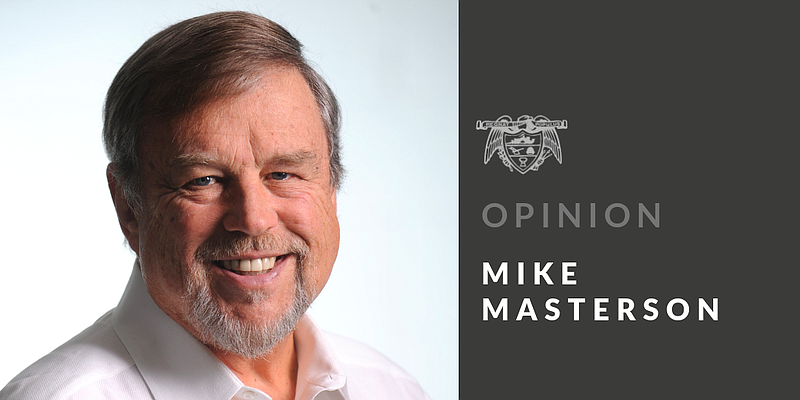The time had arrived after weeks of preparation and testing.
On this morning I'm face up on a hard treatment table, alone, arms at my side, staring into the single eye of a white plastic-lined linear accelerator practically the size of a Volkswagen Beetle.
My thoughts range between hopes that this machine over our next 35 days together will end the squamous cell cancer growing in my neck and the faith I place in my creator that it can and will.
The many of you who were kind enough to write and who have endured similar treatments ensure me that maintaining a positive attitude and faith are enormous assets in such battles. I thank you sincerely for the statewide outpouring of well wishes and prayers.
All the preparations for this moment are complete. It's not like simply lying back and allowing the radiation to pour over your cancer. Not even close. The purple plastic mesh mask that will hold my head perfectly still during the 10-minute, 12-application treatments has it firmly locked down.
The precise marks on the treatment areas of my chest and neck by veteran radiation therapists Shannon Hilliard and Kim Coker have been sketched and tattooed on my skin. The process is more methodical than I expected.
My hands grip ropes that will keep my shoulders pulled out of the photon field.
They do one final check before stepping out of the heavily sheltered room to prevent being overdosed by the cancer-killing beams.
Just that suddenly, the accelerator begins to hum, click and whir around my head as it sets out to fulfill its latest mission of the 15 or so such treatments it carries out daily on various patients.
I stare at the ceiling's stained-glass artwork of a sun-dappled wooded brook in the forest and a two-pound rainbow trout breaking water. Barely visible in the far left corner tree is a shadowy (and likely hungry) eagle watching.
The mask is confining and a bit claustrophobic, but its mesh allows me to breathe freely. The gantry methodically swings from one side of my head to the other, pausing to emit a high-pitched tone each time it delivers its beam to a programmed spot on the tumor, as designed by Claude Parrish Cancer Center oncologist Dr. Arnold Smith.
Intensity-modulated radiation therapy (IMRT) is an advanced type of radiation therapy used to treat cancer and noncancerous tumors. It uses advanced technology to manipulate photon and proton beams of radiation to conform to the shape of a tumor.
It has become the mainstay of cancer radiation treatment in cancer centers across the country, from the vaunted MD Anderson Cancer Center in Houston, Texas, to this facility serving surrounding several counties high in the Ozarks.
Seated before computers on the other side of the dense wall, Kim and Shannon carefully watch through a safety window everything I do, and break in over loudspeaker if they need to offer advice or communicate.
When I say these teammates are methodical, I mean just that. They notice if I make even the slightest movement, or am inadvertently gripping the ropes too tightly. They tell me that if I ever need to stop the process to just lift my legs and they will be there.
When I'm not staring into the tranquility of the brook, my eyes are closed in prayer and seeking support for this impressive piece of mechanical equipment constantly dancing around me.
In fact, I dreamed up my own helpful scenario for just that. I envision a platoon of little SEAL teamers in hazmat suits armed with flame throwers as they join the radiation in wading into the tumor with fires blazing to help steadily consume the unwelcome beast.
Hey, it seemed reasonable enough to help all I can. Besides, what possible harm could such conjurings do?
The only moments I'm allowed to swallow during treatment is when the beam's tone isn't sounding. That part is mostly manageable. The only time I feel anything comes toward the end of my 10 minutes when the confinement begins to seem more like 20. That's true with anything in this life, I suspect.
After all, when most of us are mentally ready for anything to be over with, we are definitely ready.
When the gantry finally comes to a rest, Shannon and Kim are quickly alongside me, unwrapping my mask and lifting me into a sitting position.
As of today, I am nine identical treatments in to what will be 35, stretching into early September. So far I've noticed a diminished appetite that makes it difficult to get the 2,100 daily calories that can help keep my weight up and ensure a maximum cure.
And that eating-enough situation could become even worse as the side effects from these treatments kick in soon to cause the "sore throat from hell, no taste, and a dry mouth."
Already living largely on a liquid diet of daily nutritional shakes, I suspect a feeding tube may become necessary to keep from losing more than 10 percent of my body weight, which is already dropping.
Then there are the four remaining weekly chemotherapy sessions designed to complement the radiation's curative effects.
The good news? After six treatments, Dr. Smith says the tumor has stopped invading. It appears the next step will be to watch as it slowly retreats into oblivion. I believe the Holy Spirit will have the guiding hand in that.
By the way, they call these the Golden Years, valued readers.
Now go out into the world and treat everyone you meet exactly like you want them to treat you.
Mike Masterson is a longtime Arkansas journalist, was editor of three Arkansas dailies and headed the master's journalism program at Ohio State University. Email him at [email protected].

